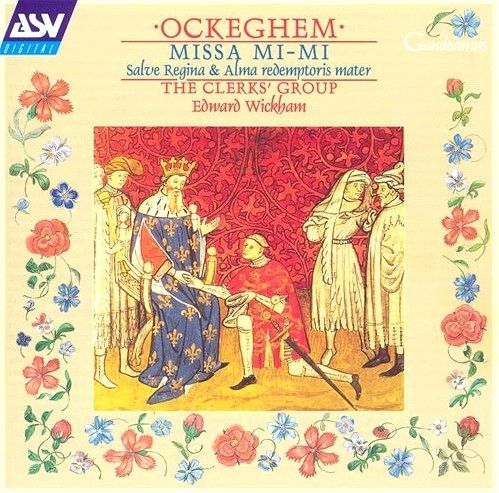
medieval.org
AS&V "Gaudeamus" CD GAU 139
1995
Johannes OCKEGHEM
(c. 1410-1497)
1. Salve Regina [8:51]
(ed. John Milsom)
Missa Mi-mi
2. Kyrie [2:20]
3. Gloria [6:56]
4. Credo [8:41]
5. Sanctus [3:38]
6. Benedictus [2:35]
7. Agnus Dei [6:10]
Jacob OBRECHT
(1457/8-1505)
8. Quod chorus vatum ~ Haec Deum caeli [5:46]
Antoine BUSNOIS
(d. 1492)
9. Victimae paschali laudes [6:03]
Heinrich ISAAC
(c.1450-1517?)
10. Angeli, Archangeli [7:10]
Johannes OCKEGHEM
11. Alma redemptoris mater [5:17]
Produced by Paul Proudman & Proudsound
Recorded by Paul Proudman & Proudsound
Recorded in St. Andrew's Church, West Wratting, 11-12 April, 1994
Designed by Studio B, The Creative People
Cover illustration: “Homage to King Charles” Bibliotheque de Toulouse / Bridgeman

If Johannes Ockeghem had set out to write music that would persistently
elude and escape modern analysis, he could not have been more
successful than he in fact is. Musicologists have long agreed that
Ockeghem's sacred musical style is best described in negative terms
— that is, by denying it the formal properties that are more
obviously present in other composers' scores. Missa Mi-mi is a
good example: no cantus firmus, little or no imitation, very few
cadences, no clear sectional divisions, little or no textural changes,
and so on. The same is true, with few exceptions, of the motets Salve
Regina and Alma redemptoris mater. At the same time we need
only listen to the music itself to recognise that these, of all
settings, are vintage Ockeghem. What then is typical about them, if
first and foremost they are not this, not that, not
anything?
Musicologists have agreed that Ockeghem's
‘writing-by-denial’ must somehow have been inspired by
spiritual idea. Intuitively one feels inclined to agree with this: his
sacred musical style is traditionally regarded as perhaps the most
reflective, inward and spiritual of the fifteenth century. And no
hearing of his masses and motets — particularly after listening
to, say, Dufay, Busnois or Obrecht — will make that statement
seem even a little exaggerated. But how can Ockeghem's apparent
avoidance of musical articulation be consistent with (or explained by)
his evident spirituality?
It was assumed until quite recently that Ockeghem's masses and motets
were musical expressions of fifteenth-century mysticism, and might have
been associated with the movement known as devotio moderna. The
mystics' trance-like experience, in this view, might have paralleled
intense musical experience, the emphasis in both being away from
rational analysis. But objections to this hypothesis have been raised
equally often: first, that the adherents of the devotio moderna,
for all their spirituality (or rather, because of it), despised
polyphonic music as ‘secular’, and second, that they
encouraged a lifestyle of poverty which Ockeghem (as wealthy treasurer
of the church of St Martin at Tours) hardly exemplified.
But ‘denial’ was not the teaching of mystical writers
alone: in fact, it was almost a commonplace in medieval scholastic
philosophy that God himself can only be known through denial (or
alternatively through revelation, as related in the scriptures). That
is to say: all that can be known positively through experience is the
world, but God can be known only negatively, by eliminating
characteristics of the world. The medieval cosmos was finite, but God
was infinite; the world was changing, but God unchanging; the world
consisted of many creatures and things, but God was single and
undivided.
Was Ockeghem's music then somehow an expression of what God was thought
to be? That seems unlikely: the Missa Mi-mi is finite, evolving
in a limited span of time, continually changing, and consists of a
multitude of (well-arranged) notes. But in the medieval view, of
course, the world itself (with which Mi-mi shares all these
characteristics) was an expression of God. And if music cannot convey
directly what God is, at least it can express something about him in
the way he expressed himself in Creation.
This idea had a long pedigree. A key principle of medieval aesthetics
was Aristotle's dictum that ‘art imitates nature’. Music
was seen as a ‘higher’ art than others in that it could
imitate nature more abstractly, more fundamentally. Where a painter or
sculptor had to be content to represent objects literally as they were,
the musician was able to represent their underlying principles of
harmony, diversity, change and compositeness. He was, in fact, able to
imitate God's very act of creation, as described in scripture: God had
arranged everything ‘with sweetness’, and ‘had
ordered all things by measure, number and weight’ (Wisdom viii.1
and xi.20). Which art but music could represent sweetness (in tone
production and consonance), measure (in rhythm), number (in notes), and
weight (in pitch)?
It was another commonplace in medieval philosophy that qualities which
existed one and undivided in God could exist in the world only in a
multitude of fragmented ways: in variety. It is no coincidence that a
major music theorist of Ockeghem's time should stress the importance of
variety as an aesthetic principle. Ockeghem perhaps went further than
most contemporaries in stepping up this variety to an extreme point. No
musical moment in his works is ever identical to the next: duplication
(imitation or repetition) is rigorously avoided. So, indeed, is
everything that might constrain the exuberance of variety in multitudes
of musical details (e.g. cadences, sectional divisions, textural
changes). This is the positive message that modern analysis can only
read as negative. Where the analyst habitually looks for musical unity
(rather than variety), Medievals believed that perfect unity exists in
God alone, and that mortals cannot know his beauty except in a
kaleidoscopic variety. Ockeghem's music, then, testifies to God's
glory, but does so indirectly, by representing the principles that
govern his Creation.
Compared to this, Antoine Busnois's motet Victimae paschali laudes
is considerably more articulate. Based on the famous Easter sequence
(which it would have been designed to replace in liturgical
celebrations), it states the melody with little ornamentation, and (at
the beginning) repeats whole blocks of musical material. This is a more
obviously functional setting, less ‘difficult’ than
Ockeghem's music, and of more direct appeal for that very reason. The
same is true of Jacob Obrecht's motet Haec Deum caeli, based on
the second verse of the hymn Quod chorus vatum. The chant
melody permeates all voices causing an amount of
‘duplication’ between parts, which creates tight unity, but
also signals a retreat from Ockeghem's extreme variety.
Heinrich Isaac is one of the most unjustly neglected composers of the
late Middle Ages. Like Obrecht he was a man of exceptional musical
ability, writing music of unparalleled skill and artistry. Like
Obrecht, too, there are always unexpected sides to his musical
personality, making the continued recording of both their music a
genuine voyage of discovery. Angeli, archangeli is a glorious
six-part motet for the feast of All Saints. The cantus firmus is not
taken from the liturgy of that feast, but, strangely, from Binchois's
famous song Comme femme desconfortée, in which a courtly
lady laments her misadventure and expresses her desire to die. The
combination seems puzzling, unless one assumes that Isaac composed his
motet for a specific Virgin-Martyr, even though his text names no saint
in particular. The motet was extremely popular in its day, and there is
no reason why it should not become a favourite today.
© Rob. C. Wegman 1994
